The Carvings
Te Pou Tokomanawa

The Pou Tokomanawa in the foyer represents the whenua tukuiho (land handed down), those lands being Mangatu Land Blocks, 1 to 6.
The figures represent the groups who occupied the lands and who agreed to the incorporation of these lands into the organization known today as Mangatu Blocks. It honours settlers Ngariki & Ngati Wahia, the original Trustees (Wi Haronga, Wi Pere, Matenga Taihuka, Pera Te Uetuku, Tiopira Tawhiao, Hori Puru, Tiopira Korehe, Anaru Matete, Pirihi Tutekohi, Rutene Ahuroa, Peka Kerekere and Paora Kingi), the inaugural Corporate Body (Hetekia Te Kani Pere, Pera Te Uetuku, Hori Puru, Peka Kerekere, Pirihi Tutekohi, Rutene Ahuroa and Matenga Taihuka) and the later inclusion of Taupara.
The Maori Land Court awarded Mangatu No.l to Ngariki and Wahia. In 1917 Taupara petitioned parliament to be included in the award for this block, which was granted in 1923. Mangatu No.3 was awarded to Whakauaki. Mangatu No.4 was awarded to Taupara and Wahia.
Paoa

Grandson of Ngatoroirangi I (the priest of the Arawa canoe), Paoa captained the Horouta canoe, arriving at Ohiwa in the Bay of Plenty in 1325AD. It is with his arrival that our traditional history begins.
In an attempt to cross a sandbar named Tukerae o Kanawa, the haumi of the Horouta was damaged. Paoa took a party of warriors inland to search for a suitable tree for repairs. On a large mountain they found what they sought, and named the mountain Maungahaumi. There, Paoa relieved himself, forming both Te Mimi a Paoa (the Waipaoa River, which flowed south to an outlet at Kopututea) and the Motu River (which flowed north of the mountain to Te Whanau a Apanui).
Eventually repaired, the waka headed east, rounding the East Cape. It then followed the coastline south, greeting the descendants of Toi, replenishing water and food as they went. Some of the Horouta descendants remained and settled with the Toi, the rest continued south.
The name of our land is taken from this incident, “te manga i tu ai te rakau a Paoa ara ko Mangatu”.
Kiwa

Kiwa, with a skeleton crew, took the Horouta canoe from Ohiwa around the cape. They travelled until they reached a large bay where Kiwa set up a rahui tuahu – claiming the area in the names of the remaining crew of Horouta, and giving the name Turanganui a Kiwa to the area and the waters.
To commemorate their journey Paoa gave his daughter, Hineakua, in marriage to Kahutuanui, the son of Kiwa.
While it is important to note that most of the people of Turanganui a Kiwa trace their whakapapa to these two important sea voyagers (Paoa and Kiwa), Te Moananui a Kiwa and Turanganui a Kiwa take their name from this ancient voyager.
Nga Waharua
This double-layered diamond-shaped pattern symbolizes two mouths or voices.
It represents a person who has been elected to speak not only for themselves, but to speak on behalf of two tribes or to represent his mother’s and his father’s family – a person who has been authorized to represent people including his own. It is often used to represent a peacemaker or person with the ability to pass judgment in a debate or settle an issue, an expert on whakapapa.
This particular Waharua pattern, with the third stitching over the second, was originally woven in error but has been accepted amongst tukutuku weavers. This particular pattern has been named after the originator, Waioeka Brown, and is known as Te Waharua a Waioeka, Te Waha Toru.
Paramount in importance was the guarding of the navel, a vulnerable part of the anatomy. This pattern represents the defences and fortifications of man in his striving to protect his person and property.
Taki Toru
The Taki Toru pattern has a biblical story attached to it, referring back to the time of Noah.
Noah, his family and a menagerie of animals and birds were floating on the great expanse of the water. The day eventually arrived when Noah liberated one of his doves. (Genesis 8:7-12)
This was the taki toru; the three things, the three attempts, the three objects.
This pattern is also shown in our whare puni. Attached to the under purlins in the ceilings are the patterns of three.
These represent the three questions:
Ko wai koe? – Who are you?
No whea koe? – Where did you come from?
E haere ana koe ki whea? – Where are you going?
Ko taku maunga ko Maungahaumi
Ko taku awa ko Waipaoa
Ko taku iwi ko Te Aitanga a Mahaki
Ruapani
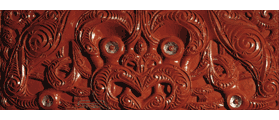
Ruapani lived about 1525 AD, and on him converged all the main whakapapa lines from Paoa, Kiwa and other chiefs from the Horouta canoe.
Ruapani lived at Popoia on the Pukepapa Block, about 25 kilometres from Turanganui. His daughter, Ruarauhanga, from his first wife Wairau, married Kahungunu. This union produced the Kahunoke and Te Nonoikura families, the founding ancestors of Te Aitanga a Mahaki, who are represented in the Whare Whakairo.
The second wife of Ruapani was Uenukukoihu and from this union were born seventeen children, the first birth being triplets, Ruatapunui, Ruatapuwahine and Rongokaro. Ruatapuwahine married Kahukuranui, the eldest child of Rongomaiwahine and Kahungunu. From this union was born Rakaihikuroa, the father of Tupurupuru.
The third wife of Ruapani was Rongomaipapa, the second child of Kahungunu and Rongomaiwahine. When Ruapani died Rongomaipapa was taken away by Tuhourangi as his wife and founded the Tuhourangi people of Whakarewarewa.
Ruapani died at Mohaka and his body was returned to Turanga and buried in a cave at Wharekorero on the Wainui Beach.
Tauheikuri

Because Kahungunu was not accepted by the people at Popoia Pa, he moved on to Nukutaurua where he took the wife of Tamatakutai, Rongomaiwahine. Their union produced many of the ancestors of Te Aitanga a Mahaki including Tauheikuri. The carving is of Tauheikuri with Tamataipunoa. At her feet is the child Tawhiwhi.
Kahukuranui and Rongomaipapa. Tamateakota was the father of Kahutapere, who married Hineteaorangi, the parents of the twins Tarakiuta and Tarakitai.
The last child of Kahungunu and Rongomaiwahine was Tauheikuri who was betrothed to Tamataipunoa, the half brother of Tutamure, of Te Whakatohea. The marriage came about because Tutamure and his half brother had brought a war party to Mahia to attack Maungakahia, the pa of Kahungunu and Rongomaiwahine.
During the siege Kahungunu recognized that his nephew was leading the attacking forces. He asked that there be a peace pact between them and offered his daughter, Tauheikuri in marriage. When Tauheikuri went amongst the invaders she went to Tamataipunoa who was the younger and more handsome of the two leaders. Tamataipunoa tried to push her off to his brother but she persisted with her choice.
Tutamure went to look at his reflection in a pool of water and agreed that Tamataipunoa was the better looking person and agreed to the marriage but warned that the couple must never return to Te Whakatohea. The pool is known as Te Wai Whakaata a Tutamure.
The union of Tamataipunoa and Tauheikuri produced the two brothers Tawhiwhi and Mahaki.
The carving is of Tauheikuri with Tamataipunoa. At her feet is the child Tawhiwhi, who was killed and cooked in an umu close to the monument above the Kaiti Freezing Works.
Mahaki

The carved figure represents Mahaki, the eponymous ancestor of Te Aitanga a Mahaki, with his wife Hinetapuarau and their second son Hikarongo.
Mahaki, the second son of Tauheikuri and Tamataipunoa, married Hinetapuarau, though she was already betrothed to Hingaanga. The couple eloped and lived at Pakarae under the protection of Tamateakuku. They produced five daughters and three sons and, in later years, moved to Pawerawera, on the Waihuka Block.
Of their three sons it was their second, Hikarongo, who married Tukorako and it was their descendants that became known as Ngati Hikarongo. Their lands were Ahirau, Poututu and Waikohu-Matawai.
Mahaki did not have manawhenua status within Turanganui a Kiwa. However, by forming strategic alliances and conducting successful battles against the families of Ruapani, the children and grandchildren of Mahaki were able to establish the people known today as Te Aitanga a Mahaki.
An excuse to engage in battle against the families of Hinemanuhiri and Rakaipaaka was presented to Tutekohi and Mahaki when members of this group from Mahia stole, killed and ate Kauerehuanui, the dog of Tutekohi. The ensuing battle was known as Te Takoremu o Mahaki “the jaws of Mahaki”, resulting in the banishment of Rakaipaaka and Hinemanuhiri from the Turanganui lands.
Te Ranginui-a-Ihu

The carving represents Te Ranginui-a-Ihu, his wife Te Nonoikura and one of their children, Mokaituatini.
Te Ranginui-a-Ihu, or Ihu, was the eldest son of Mahaki and Hinetapuarau. He married Te Nonoikura and from this union descend most of the hapu groups of Te Aitanga a Mahaki.
Parua, of Ngati Kahungunu, built a house in Te Karaka and stated that he would use the heart of Te Ranginui-a-Ihu to bless the building. On hearing this threat Te Ranginui-a-Ihu sent his son Taupara to Maraenui to raise the fighting force of Te Whanau-a-Apanui. In appreciation of their support Te Ranginui-a-Ihu gifted the greenstone axe Whakatangiura to Te Whanau-a-Apanui.
Some time later Te Ranginui-a-Ihu ,with Te Nonoikura and their children Whakauaki and Taupara, visited Houpapa in the Tahora area. Hinepuakirangi, the daughter of Parua, noticed the visitors and sent a message to Kauwaetere of Te Wairoa to exact revenge on Te Ranginui-a-Ihu and Te Nonoikura.
When Te Ranginui-a-Ihu saw the arrival of Kauwaetere he warned his sons to leave, taking the son of Whakauaki, Te Kuru-o-Terangi, with them. They were to take a greenstone axe, Te Whatu-o-Poutini, and sue it to raise a force to exact revenge for their deaths. Whakauaki refused to go and sent Taupara away with his son.
Again Taupara sought assistance from Te Whanau-a-Apanui. They raised a fighting force and went to Te Wairoa where they killed the people who were responsible for the death of Te Ranginui-a-Ihu, Te Nonoikura and Whakauaki.
Whakarau

The carving represents Whakarau (the youngest son of Te Ranginui-a-Ihu and Te Nonoikura), his third wife Huruhuru and one of their children, Takorokahu. Whakarau is the ancestor of Ngapotiki. Their lands being Manukawhitikitiki, Tapuihikitia, Puhatikotiko, Rangatira, Motu, Poututu. Takorokahu eventually had the responsibility of holding the boundary on the east between Te Aitanga a Mahaki and Ngati Ira.
The twins Tara-ki-uta and Tara-ki-tai, the sons of Kahutapere, were captured at Korowhio-a-rau on Te Muhunga Block, and killed by Tupurupuru on the instructions of his father Rakaihikuroa, “Kia kotahi te whetu i te rangi ko Tupurupuru.” Rakaihikuroa ordered the death of the twins because the people were bringing gifts and food to the sons of Kahutapere rather than to his son Tupurupuru.
To exact revenge Kahutapere sought assistance from the whanau of his cousin, Mahaki.
The battle took place at Pukepoto, the pa of Rakaihikuroa, on the Okahuatiu Block, where Whakarau killed Tupurupuru with his spear. As his warriors tried to remove the weapon Whakarau stated “waiho i kona te ika o te potiki a Hinetapuarau kia kahakihaki.” From this incident came the name of the hapu, Ngapotiki.
The result of this battle was the exodus of Rakaihikuroa and his family from their lands in Turanganui a Kiwa.
Tamateaiti

The carving represents Tamateaiti, his wife Hinetera and their son, Tutepuaki. Tamateaiti is the ancestor of Ngai Tamatea.
Tamateaiti, was the son of Kahunoke, the grandson of Ruapani, who married Hinetera, the daughter of Hauiti. This union produced Tutepuaki.
Takorokahu, the child in the carving of Whakarau, visited Tutepuaki and saw the smoke of the fires of Ngati Ira from Tautaringa pa (at Whatatutu) and Tipare pa (at Tapuihikitia) and enquired who lived at these pa. Tutepuaki answered that they were the fires of Ngati Ira.
Takorokahu led a war party that defeated Ngati Ira who in turn retreated to Mangamutu on the Whatatutu Block. Takorokahu gave chase and Ngati Ira were again defeated and retreated to Te Whakaniwha, a pa on Te Pakake a Whirikoka Block. Here, they were defeated again, finally moving back to their lands at Huiarua.
Tamateaiti is the ancestor of Ngai Tamatea, their lands being:
Land Block
Waipaoa
Mangatu No2
Waingaromia No3
Mangataikapua
Te Hauomatuku
Tutamoe
Tauwhareparae
Place Names
Arowhana; Otuhawaiki; Waengarepo; Kereruhuahua; Mangaorongo
Tawhiti a Takitahi; Wheturau
Arakihi; Ahititi; Te Ngarara a Tamatea
Totaramaitawhiti; Opihi
Kopuapara
Whakerokero; Tangihanga
Te Toto; Hinatore
Kaikoreaunei

The carving represents Kaikoreaunei, his two wives and their children. The descendants of Kaikoreaunei are known today as Te Whanau a Kai.
Kaikoreaunei, or Kai, grandson of Mahaki and son of Te Ranginui-a-ihu and Te Nonoikura, married two sisters Whareana and Te Haaki. They were the daughters of Paeko and lived on the Okahuatiu Block.
Whareana had Te Hau-o-Terangi, who had Rongo-i-waho and Torohina. Te Haaki had Rangiaia and Wharawhara-ki-Terangi who married Wahia.
The descendants of Kai’s son, Te Hau-o-Terangi, lived at Okahuatiu Pa and kept the name, Te Whanau a Kai and it was Te Hau-o-Terangi assisted Takorokahu and Rongowhakaata in their battle to avenge the death of Kaipoho
The descendants of Rangiaia were called Ngai Te Ika.
Outstanding leaders that descended from this whanau included Te Iho-o-Terangi (the grandson of Rongo-i-waho) and Torohina – who fought with Tama-i-uia against Nga Maihi. A boundary marker named Rimuroa was erected by Torohina at the junction of Houhere and Tataweka to mark the boundary between Nga Maihi and Ngati Hine.
Their lands are, Hangaroa Matawai, Kaimoe, Okahuatiu, Wharekopae, Te Wera, Houpapa, Oariki, Kahunui, Patutahi, Repongaere, Tahora, Tangihanga
Marae of Te Whanau a Kai are; Pakohai, Rongopai, Te Mokonui a Rangi and Ngatapa.
Tauwheoro

The carving represents Tauwheoro, her husband Iwipuru and their child Hokinga-i-Terangi – the ancestors of Te Whanau a Iwi.
Tauwheoro, the only daughter of Te Ranginui-a-Ihu and Te Nonoikura, married Iwipuru and had Te Hokinga-i-Terangi, Kuriwahanui and Te Rangikuatipuiwaho.
Iwipuru and his relatives were slain by his brothers-in-law because of a kopae pakapaka insult. The second son of Te Ranginui-a-Ihu, Mokaituatini, and his cousin Tungenge, the son of Ihu’s sister Rakaiaotea, chased after the escapees of this battle to the hilltops above Waihirere Domain.
The first encounter continued until darkness where Mokaituatini received a gash to his head at the place now known as Te Kotinga o Mokaituatini. In spite of his wounds he managed to kill two of the enemy before being slain himself. This battle is remembered in the lament by Kahutia for his daughter Makerewhatu.
The sons of Tauwheoro, Kuriwahanui and Rangikuatipu, established homes on the Whataupoko Block. Their sister, Hokinga-i-Terangi, remained with her husband Whakauika in Te Uku Pa on the Rangatira Block.
The lands of Te Whanau a Iwi are: Part of Kaiti, Makauri, Turanganui, Waikanae, Whataupoko, Taruheru, Tahoka, Mangamoteo, Waiohiharore.
The first land purchased in the Turanga district, on 29th January 1857 by the Crown was 57 acres close to the Taruheru river, the area presently used for the Makaraka Cemetery (Houhoupiko).
Whakauaki

The carving represents Whakauaki, his wife Rangiwhatia, and their son Te Kuru-o-Terangi who lived for a time at the Pa o Tamarere and who’s descendants spread over Mangatu No3, Puhatikotiko No5 and No6, Poututu B, Manukawhitikitiki and part of Tapuihikitia.
Following the death of his father at Te Houpapa, Te Kuru-o-Terangi was raised by his uncles Te Ranginaonaoariki and Taupara.
He married Tawhao and lived at the Pa o Tamarere. They had two sons, Huru-o-Terangi and Mutu-o-Terangi and their descendants spread over the following land blocks: Mangatu No3, Puhatikotiko No5 and No6, Poututu B, Manukawhitikitiki and part of Tapuihikitia.
Place names are: Tarainga Tao a Te Kuru on the east end of Poututu B and Kotikoti a Tawhao on Puhatikotiko No6.
Te Huru and Te Mutu divided Poututu between themselves, the latter living at the Pa o Houmea and Te Huru at the Pa o Tamarere and the Pa o Pouaha.
Arikinui

The earliest settlers in the Hangaroa and Mangatu areas were descended from Arikinui whose descendants later founded the groups collectively known as Ngariki. Ngariki occupied the Waimaha Block, Tahora 2C2, Tahora 2C3 and the western portion of Hangaroa-Matawai and the Okakuatiu No2 block.
Among the known groups of Ngariki are: Ngati Rua, Ngati Maru, Ngariki Ratoawe, Ngariki Kaiputahi, Ngati Rutunga and Ngati Hine.
Ngati Rua take their name from Ruarapua who lived at Te Turi o Ruarapua on Tahora 2C1 or the Waimaha Block. Ngati Rua and Ngati Maru were co-owners of the block and their boundary was the Hangaroa river.
Ngati Maru are the descendants of Marutaiaroa. In addition to Tahora 2C1 they also owned Tahora 2C2, the western portion of Hangaroa-Matawai and the Okakuatiu No2 block.
The ancestors of Ngariki Ratoawe were the earliest inhabitants of Mangatu who, over time were absorbed into Te Aitanga a Mahaki.
Ngariki Kaiputahi take their name from their ancestor Kaiputahi. Marukakoa, an ancestor of this group, lived at Pariaute teaching Hauiti the art of warfare, who in turn used his knowledge to banish his brothers, Mahaki Ewekaroro and Taua, from their ancestral lands at Uawa.
Ngati Rutunga take their name from Rutunga, the wife of Ruaariki, who lived at Tirotirowhetu pa on Maungapuremu above the Ormond settlement.
Ngati Hine were the original owners of Tahora 2C3, the Wharekopae, Tangihanga, Okahuatiu No1 and Repongaere blocks. This group take their name from their ancestress, Hinetai, and claim rights of descent and occupation from Maia.
Hine Te Ariki

The carving represents Hine Te Ariki, her husband Tumokonui and children Tamakiuta and Tamakiwaho. Tumokonui is the ancestor of this section of Nga Potiki and their lands are Toreohaua and Waituhi, Hihiroa, Waihuka, Poututu A, Waikohu-Matawai, Motu.
Hine Te Ariki, a descendant of Kaiputahi, married Tumokonui, a grandson of Mahaki, and had Tonoakiaua and Rongomatahuna.
Their first children were three sets of twins who were all taken by spirits. Hine Te Ariki asked her father, Whanotukurangi, for advice. He replied; “ Did you not know that I am descended from the taniwha? Beware, that when you see the clouds descending at the time of birth. You must remain over your child until it lifts, for in that mist are the spirits of your ancestors”.
Her next three children survived and were named Tonoakiaua (in rememberance of her seeking advice from her father) Hinekupa and Rongomatahuna.
Legend of Te Aitanga a Mahaki says that when Hine Te Ariki died she became a Taniwha and lives in Te Waikohu river below Kokoariki Pa.
Ruawairau

The carving represents Ruawairau, his wife Paterangi and child Rakaihuna. The Ngati Ruawairau lands comprised five out of the seven Matawhero Blocks, and the Whenuakura Block across the Waipaoa River, Awapuni, Kaiporo, Whakawhitira and Te Pa-o-Kahu.
Ruawairau was Tutekohi’s older brother and lived on the Paokahu Block next to the Awapuni Lagoon. He married Paterangi whose parents were Muia of Ngai Tahu and Torohanga of Te Tini a Toi; her sisters Rakaitekura and Te Aorere both married Tutekohi.
The boundary between Ruawairau and Wharerau of Rongowhakaata was at Te Wai o Tamarereao, where the grave of Rongowhakaata was washed away. Before then, the tidal portion of the Waipaoa, known as Kopututea, flowed into the Awapuni Lagoon and out to sea at Ohikarongo.
The son of Ruawairau, Rakaihuna, lived at Te Rua o Rakaihuna on the Waikanae Stream.
The daughter of Ruawairau,Te Aokauirangi, lived with her husband, Tahitokura, at Tauparapara,near the present Matawhero Stockyards.
Tamarere II

The carving represents Tamarere II, his wife Rakaimaro and child Marotiripawa.
Tamarere II was the son of Hirangi and Tamahuatahi, whose father was Tamarere I of Ngariki Ratoawe.
Tamarere II married Rakaimaro, the eldest daughter of Mahaki, and had Marotiriopawa – whose descendants founded the Ngai Tama hapu after Tamarere II.
Tamarere I lived on the south side of the Urukokomuka river in the Pa o Tongariro on the Poututu block. His lands were Mangatu No3; Poututu and Puhatikotiko.
Tamarere I and his brother Porangahau descended from brothers Matuaiti and Matuatonga of the Mataatua canoe.
From Marotiripawa were descended Maahu and Marere who assisted Tamanuhiri of Te Whanau a Iwi in the battle against Ngati Ira at Tauwhareparae. For their assistance Marere was given Whataupoko 9 and 10 blocks and Maahu was given the Waimata West and Kopaatuaki blocks.
The lands of Ngai Tama were: Papakorokoro No3; Kopaatuaki; Ahirau; Waihirere; Ngakoroa; Whataupoko;Waimata West.
Tama-i-uia

The carving represents Tama-i-uia, his wife Utatu and their child Te Rapinga. Tama-i-uia was a prominent chief of Te Aitanga a Mahaki, solely responsible for policing the boundaries of this rohe, with boundaries to Whakatohea in the north and west, to Ngati Porou in the north and east, to Kahungunu in the south, to Tuhoe in the west.
The boundary that he had set up between Te Aitanga a Mahaki and Tuhoe, was defined by a selected rock called Te Puhinui, situated at Waikohu close to Te Tahora. He also declared boundaries on the east coast, close to Tolaga Bay, at Hinatore.
During his absence his pa was raided by Ngati Porou, and two of his children were taken captive. Some escaped from the pa, and reported the kidnapping to Tama-i-uia who gathered together the strong fighting force of Te Aitanga a Mahaki, and set off after the invaders.
Swiftly following the tracks of the fleeing enemy he outpaced his warriors and reached the outer walls of the Ngati Porou stronghold alone. He was seen by his warriors to stop and then fall to the ground. The warriors ran to him, and found that he was embracing his two children, who had been lowered over the walls.
He was so pleased that he made a pact of peace with these people. In this very spot, he set up the Pou Rohe, Hinatore Te Pou. His quotation: “Ko Te Huiwhenua ki tena taha, ko Tama-i-uia ki tenei taha!” a boundary which has been respected by both tribes up to this day. Te Whiwhi, a grandson of Tama-i-uia and Te Ruru a descendant of Te Huiwhenua, have honoured and respected this pact of everlasting peace between them.
Tuketenui

The carving represents Tuketenui, his wife Te Huinga-o-Te Ao, and child Papatu-o-rangi. Tuketenui is the ancestor of Ngai Tuketenui, their lands being: Te Muhunga; Waitawake; Hapua; Wairerehua; Waihirere; Ngakoroa; Ahirau; Hauomatuku; Ruangarehu; Rakaiketeroa; Waihora.
Tuketenui, the son of Tutekohi and Hine Te Aorere and a descendant of Ruapani, married Te Huinga-o-Te Ao and had Papatu-o-Rangi.
Following insulting actions and remarks from Tutenekenga, Tuketenui killed and took over all the processions of his uncle and the people became food gatherers under their new master.
Tuketenui begat Kohakitu, in whose time Ngai Tuketenui became firmly established in the Ngai Tutekohi dynasty.
The people later tested the mana of Kohakitu by presenting live birds wrapped in leaves rather than preserving them in calabashes. It was suggested that the perpetrators be killed, however, Kohakitu did not agree.
Later, the same insult was hurled at Whakapakihau, the son of Kohakitu. However, this time Umurau enlisted the help of Tama-i-uia to banish Huriwaho, Parito and Rangimauhara to Te Arai. Later the people sought the protection of Wahoterangi at Whangara.
Taupara

The carving represents Taupara, his wife Puha-i-terangi, and child Whakauika.
Taupara, the youngest son of Te Ranginui-a-Ihu, married Puha-i-terangi, daughter of Apanui Mutu, and had Whakauika, was the founder of Te Whanau a Taupara.
Besides helping to avenge the death of his parents and brother, Whakauaki, at Houpapa and Omaruhakeke, Taupara joined his brothers in the kopae pakapaka affair at Takanga Pa on Te Taumata o Rangitawhio hill.
His first pa, Kaikomore, was on the upper reaches of the Urukokomuka river. He and his brother, Te Ranginaonaoariki, later lived in Te Uku Pa at Puketeake with their sister Tauwheoro and her children.
However, while living at Te Koutu, on the Waihora block, he frequented the Waiohiharore portion of Te Oneroa, now Waikanae Beach. There he fished with his kaharoa (seine net), and the place became known as “Te Paenga Kaharoa a Taupara (the trawling place of Taupara).
On one occasion he took fish for his brother, Kaikoreaunei, and during the visit made a pact of betrothal between the daughter of Taupara, Kuraiteapata, and Rangiaia, the son of Kaikoreaunei. The marriage produced two daughters, Waotapu and Marorakau, who both married Te Ikakaiwawe, the ancestor of Ngai Te Ika of Ngati Maru and Ngati Hine.
Their lands are; Mangataikapua, Mangatu No4, Te Karaka, Ruangarehu, Rakaiketeroa, Te Waerenga a Hika Estate lands.
Wahia

The carving represents Wahia, his wife Wharawhara-ki-terangi (the daughter of Kai), and child Ngaitahu.
Wahia was the eldest child of Te Ranginaonaoariki and Hawearangi. He became chief after his father and lived at Te Koutu Pa, east of Te Karaka. He is the ancestor of Ngati Wahia. Their lands are; Mangatu Nol, Mangatu No5, Mangatu No6 and part of Manukawhitikitiki.
As a result of the conquest of Ngariki Ratoawe, the eldest son of Te Ranginui a Ihu, Te Ranginaonaoariki, took the role of chief over the other descendants of Mahaki. This left Te Ranginaonaoariki to settle on the Urukokomuka river where he built the Haupiri Pa and married Hawearangi, the daughter of Whakarau.
Accompanied by his brothers, Mokaituatini and Taupara, Te Ranginaonaoariki visited their sister Tauwheoro and her husband Iwipuru at Takanga Pa. They witnessed the arrival of many relatives and friends, but during the welcome and entertainment that followed, the brothers were deliberately ignored by their brother-in-law and further insulted with the offer of kopae pakapaka (charred food in old kits) at meal time.
The brothers decided to punish Iwipuru, so with their cousins, Ure and Tungenge they attacked the Takanga Pa, slew Iwipuru and drove the other guests away.
They cared for their sister, Tauwheoro, and her children and established homes for them on the Whataupoko block. Following the deaths of Mokaituatini and Tungenge, Te Ranginaonaoariki and Taupara took over the conquered area at Rangatira.
Whanganui Mumu – Nga Roimata
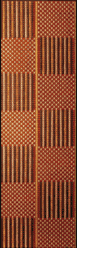
The Whanganui Mumu features a checker board pattern comprising of two divided patterns. One is made up of the Roimata Toroa and Roimata Turuturu. The other is made up of Nga Whetu o Te Rangi.
During the first period of the pakeha settlements in Wanganui, the pakeha had taught the Maori how to play Draughts. Encouraging Maori to use coins for chips, pakeha tried to substitute the coins with buttons. The Maori took offence and threatened to kill the pakeha, a small skirmish developed and, in Wanganui this escalated into a war. Hence the pattern – Te Pakanga o Te Mumu i Wanganui. Mumu is derived from the word move – your move – my move.
Poutama
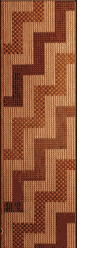
Te Poutama a Tawhaki or The Stairway of Tawhaki
In the dawn of the new year Matariki Tautoru Takurua rose on an angle with Matariki landing here.
They formed the Poutama o te Rangi – the stairway to the heavens – taken by Tawhaki to retrieve the three baskets of knowledge to bring back to earth.
Te Kete Tuauru – The basket of ancient knowledge of the gods, their genealogies and the genealogies of man.
Te Kete Tuatea – The basket of knowledge and evil things.
Te Kete Aronui – The basket of suitable things of Te Aroha. Tou hoa tata – nga tumanako. Love, hope and charity. Te hononga o nga matauranga.
These three baskets corresponded to the three levels of learning which were carried into Te Kohurau o te whare wananga.Na Tawhaki ka kitea te taumata o te matauranga – The Stairway to Knowledge.
Patikitiki

The object of the Patikitiki and its pattern indicates the Flounder Fish that was easily netted in the Islands.
Cleaned and dried, it was stored in baskets to feed the crews and passengers aboard the waka during their journeys to Aotearoa from across Te Moana nui a Kiwa to whereever they landed.
He taonga na Tangaroa. He patiki, a flat fish.
Kaokao
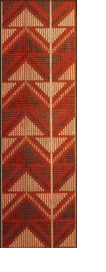
Nga Kaokao, the armpits
Nga Kuwha, the thighs
The Kaokao and the kuwha are usually patterns made into a V shape and found in the corners of a wharepuni and only in those particular places. The structure of the wharepuni is looked upon as that of an adult female. Almost all of our wharepuni bear the names of our matua wahine, wahine toa, wahine rangatira, he whare tangata, tane piripiri.
Niho Taniwha
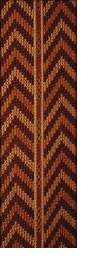
The Niho Taniwha pattern has many magnificent interpretations and varies from tribe to tribe. It is designed to represent the teeth of a serpent and some tribes would accept it to be an omen of protection.
The serpent, Te Kahukura, was lured out of the den by Tupai and Rongokako where it was captured and strapped onto the prow of their waka as a Taumata Ihu to guide them through gales and storms. As a deterrent to other waka the teeth of the serpent were visibly exposed.
The Niho Taniwha was also interpreted as a dragon from the depths of the rivers and lakes whose purpose was to act as a protector of their whanau.
The Taniwha has also been known to have extra sensory perception and could lure you into the water or lead you away from its den. A mythical monster that kills people by drowning them and devouring their eyes.
Te Tahuhu
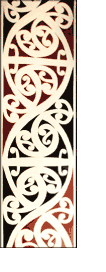
The design on the ridge pole is that of the mango pare.
The black colour represents the land.
The red colour represents our blood or the people.
The white colour represents the spirit of the people.
The lines represent our links or whakapapa.
